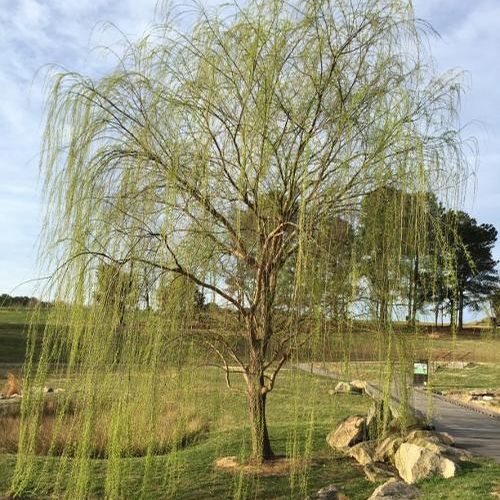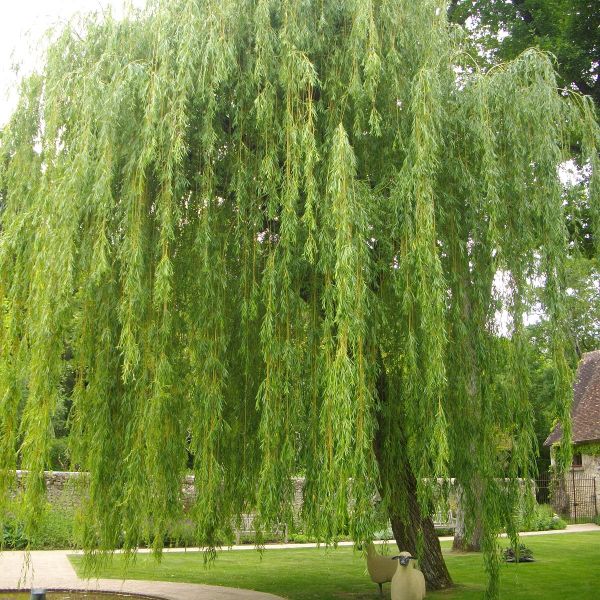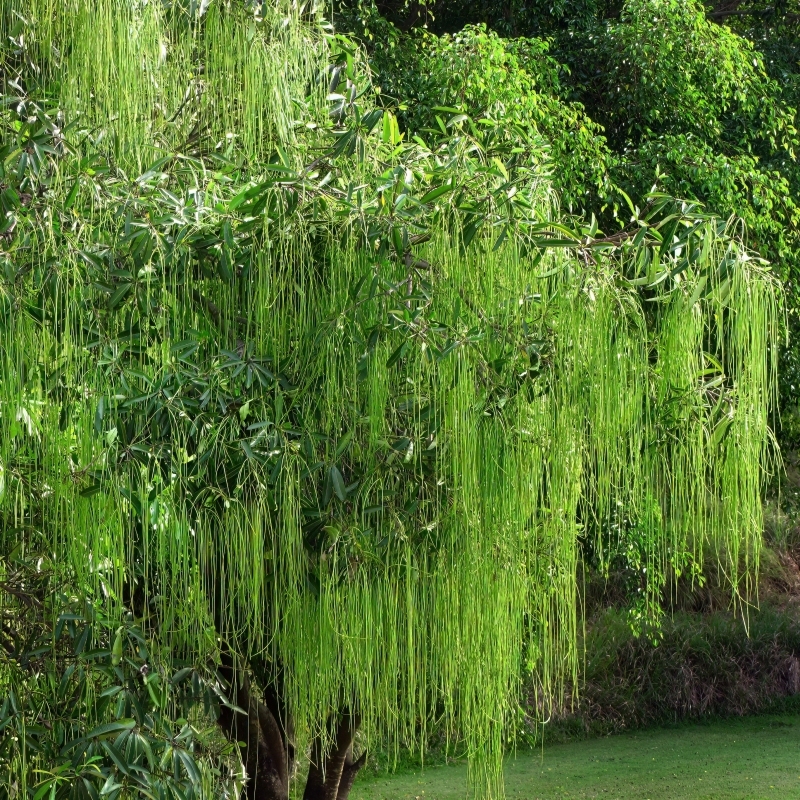





Weeping Willow Tree
Salix babylonica Weeping Willow
88 reviews
Weeping Willow Tree
Salix babylonica Weeping Willow
88 reviews
- Dramatic beauty with gracefully arching branches
- Fast-growing shade tree perfect for larger yards
- Tolerates wet soil conditions well
- Recommended by landscape designers for optimal fit in real yards
$112.00
$160.00
30% Off
- Ships to in 3-5 Days
- Free Shipping Over $150
- Plant Arrival Guarantee
- In Stock
- Free Plant Consult
$200 - Landscape-Approved: Every Plant We Sell Comes With Design Expertise Behind It
Trade 3 Gallon
We are sorry, product is currently out of stock due to seasonal availability. Please check the "Related plants available in your area" section below
Not just beautiful - intentionally selected by ShrubHub's 3D landscape design team to fit real-world spaces and maximize yard potential.
Why Weeping Willow Tree?
The Weeping Willow tree is known for its graceful, drooping branches that create a cascading effect. Native to China, it can reach heights of up to 50 feet and thrives in wet soil conditions. It gets its name from the way its branches hang down, resembling tears. The tree has a striking appearance and is often planted for its beauty in landscaping.
Sunlight
Weeping Willow Trees thrive in full sun to partial shade conditions. They require at least 6 hours of direct sunlight per day to grow and develop properly. However, they can also tolerate some shade, especially in hot climates.
Watering
Weeping Willow Trees require consistently moist soil, especially during the first few years after planting. They prefer to have their roots in damp soil but not sitting in water. Water deeply once or twice a week, depending on rainfall and temperature.
Fertilizing
Weeping Willow trees have moderate fertilizer requirements and benefit from applications of a balanced fertilizer in the spring. Use a slow-release fertilizer high in nitrogen to promote healthy growth. Avoid over-fertilizing, as this can lead to excessive
Weeping Willow Tree (Salix babylonica Weeping Willow)
The Weeping Willow Tree, or Salix babylonica, is a graceful and elegant tree known for its long, flowing branches that hang down like curtains. Native to China, the Weeping Willow has become a popular ornamental tree in many parts of the world for its unique beauty and peaceful presence.
These trees typically grow to heights of 30-40 feet, with a spread of 35-45 feet. They thrive in moist, well-drained soil and prefer full sun to partial shade. Weeping Willows are deciduous trees, meaning they shed their leaves in the fall and remain bare throughout the winter months.
In the spring, the Weeping Willow tree produces small, yellow flowers that dangle from its branches. These flowers are followed by long, slender leaves that are a bright green color during the growing season and turn a vibrant yellow in the fall.
The Weeping Willow tree is a great addition to any landscape that needs a touch of elegance and tranquility. Whether planted near a pond or on its own in a grassy area, the Weeping Willow is sure to make a statement with its unique appearance and soothing presence.
Plant Information:
| Botanical Name: | Salix babylonica Weeping Willow |
| USDA Zones: | 6 - 8 |
| Mature Height: | 50 FT |




Pollination Info
Weeping Willow Tree (Salix babylonica)
The Weeping Willow tree, scientifically known as Salix babylonica, is a deciduous tree native to China. This tree is known for its graceful, drooping branches that sway in the wind and create a beautiful canopy.
Pollination
Weeping Willow trees are dioecious, meaning they have separate male and female trees. The male trees produce catkins in the spring, which release pollen into the air. The wind then carries this pollen to the female trees, fertilizing the flowers and producing seeds.
Bees may also play a role in pollinating Weeping Willow trees, as they are attracted to the flowers for their nectar.
It is important to plant both male and female Weeping Willow trees in close proximity to ensure proper pollination and seed production.
FAQ
Weeping Willow Tree (Salix babylonica)
General Information
The Weeping Willow is a graceful and fast-growing tree known for its distinctive drooping branches and long, narrow leaves. It is a popular choice for landscaping due to its elegant appearance and ability to thrive in moist environments.
FAQ
Q: How tall does a Weeping Willow tree typically grow?
A: Weeping Willow trees can reach heights of 30 to 50 feet on average, but some specimens have been known to grow even taller.
Q: What kind of soil does a Weeping Willow tree prefer?
A: Weeping Willows thrive in moist, well-drained soil, but can also tolerate some degree of flooding. They prefer soil with a pH level between 6.0 and 8.0.
Q: How often should I water a Weeping Willow tree?
A: Weeping Willows require regular watering, especially during hot and dry periods. Ensure the soil remains consistently moist, but avoid waterlogging the roots.
Q: How do I prune a Weeping Willow tree?
A: Pruning should be done during the winter months while the tree is dormant. Remove any dead or damaged branches, as well as any overgrown or crossing branches to maintain the tree's shape and health.
Q: Are Weeping Willow trees prone to any diseases or pests?
A: Weeping Willows can be susceptible to diseases such as powdery mildew, root rot, and canker. They may also attract pests like aphids and caterpillars. Regular inspection and proper care can help prevent these issues.
Q: Can I plant a Weeping Willow tree near a water source?
A: Yes, Weeping Willows are well-suited for planting near water sources like ponds, rivers, or streams. Their roots help stabilize soil along water banks and can thrive in moist conditions.
Planting & Care
Weeping Willow Tree Planting & Care
The weeping willow tree, scientifically known as Salix babylonica, is a graceful and majestic tree commonly found near water bodies. Here are some tips on planting and caring for a weeping willow tree:
Planting:
- Choose a location with full sun to partial shade and moist, well-draining soil.
- Dig a hole that is two to three times wider than the root ball of the tree.
- Place the tree in the hole and backfill with soil, making sure the tree is planted at the same level it was in the nursery.
- Water the tree thoroughly after planting.
Care:
- Water the weeping willow tree regularly, especially during dry periods, to keep the soil moist.
- Mulch around the base of the tree to help retain moisture and suppress weeds.
- Prune the tree in late winter or early spring to remove dead or damaged branches and maintain its shape.
- Fertilize the tree once a year in early spring with a balanced fertilizer to promote healthy growth.
- Monitor the tree for pests and diseases, and take appropriate measures to control them if necessary.
With proper planting and care, a weeping willow tree can provide shade, beauty, and a sense of tranquility to your landscape.
Check Out These Verified Customer Reviews:
Customer Reviews
4.7 out of 5 based on 88 reviews
Thank you! Your review has been submitted.
The tree had a small blemish upon arrival, but overall still satisfied with my purchase.
The tree is thriving in my garden, very pleased with its growth.
The tree looks stunning in my garden
Item has been added to your cart.


